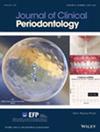A Multi-Centre Randomised Controlled Trial Comparing dPTFE Membrane to Collagen Membrane in Lateral Bone Augmentation at Single Sites in the Anterior Maxilla: 1-Year Results.
IF 5.8
1区 医学
Q1 DENTISTRY, ORAL SURGERY & MEDICINE
引用次数: 0
Abstract
AIM To compare a dense polytetrafluoroethylene (dPTFE) membrane with a collagen membrane in guided bone regeneration for lateral bone augmentation at single sites in the anterior maxilla in terms of alveolar width, height, complications, need for additional therapy and implant outcomes. MATERIALS AND METHODS Patients with a class 4 defect at a single site in the anterior maxilla (15-25) were recruited at five centres. Following flap elevation and conditioning of the recipient site, they were randomly allocated to the dPTFE membrane group or the collagen membrane group. Nine months following bone augmentation, re-entry was performed and implants were placed. Alveolar dimensions were assessed on superimposed cone-beam computed tomography images taken prior to surgery, immediately post operation and at 9 months. Implant outcomes were registered 1 year after bone augmentation. RESULTS Thirty-six patients were randomised (dPTFE membrane group: 8 females, 10 males, mean age 39; collagen membrane group: 14 females, 4 males, mean age 51) and all complied until the 1-year follow-up. At 9 months, the estimated marginal mean alveolar width was not significantly different between the groups (estimated marginal mean difference at 3 mm below the crest: 0.65 mm; 95% CI: -0.82 to 2.12; p = 0.381). Infection occurred in 6/18 patients treated with a dPTFE membrane and in 0/18 patients treated with a collagen membrane (p = 0.019). Infection occurred in every centre and had a negative impact on the alveolar width at 9 months, despite taking anti-infective measures in every patient and additional bone augmentation in two patients. Implants could be installed in a prosthetically driven position, integrated uneventfully and yielded minimal marginal bone loss. CONCLUSION dPTFE membrane and collagen membrane are both effective in lateral bone augmentation. However, dPTFE membrane is more prone to infection than collagen membrane, thereby increasing the need for additional therapy. TRIAL REGISTRATION ClinicalTrials.gov identifier: NCT05426616.一项多中心随机对照试验比较dPTFE膜和胶原膜在上颌前侧单个部位的侧骨增强:1年的结果。
目的比较密集聚四氟乙烯(dPTFE)膜与胶原膜在上颌前牙单侧骨增强引导下骨再生中的牙槽宽度、高度、并发症、额外治疗需求和种植效果。材料与方法在5个中心招募上颌前侧单一部位有4级缺损的患者(15-25)。皮瓣提升及受体部位调理后,随机分为dPTFE膜组和胶原膜组。骨增强术后9个月,再次入骨并放置植入物。通过术前、术后即刻和术后9个月的锥形束计算机断层扫描图像评估肺泡尺寸。植体结果记录于骨增强术后1年。结果36例患者随机分为dPTFE膜组:女性8例,男性10例,平均年龄39岁;胶原膜组:女性14例,男性4例,平均年龄51岁,随访1年。在9个月时,两组间估计的边缘平均肺泡宽度无显著差异(牙嵴下3 mm处估计的边缘平均差异:0.65 mm;95% CI: -0.82 ~ 2.12;p = 0.381)。dPTFE膜组感染发生率为6/18,胶原膜组感染发生率为0/18 (p = 0.019)。尽管每个患者都采取了抗感染措施,并在2例患者中进行了额外的骨增强,但每个中心都发生了感染,并在9个月时对牙槽骨宽度产生了负面影响。种植体可以安装在假体驱动的位置,整合平稳,产生最小的边缘骨损失。结论dptfe膜与胶原膜均可用于侧骨增强。然而,dPTFE膜比胶原膜更容易感染,因此增加了额外治疗的需要。临床试验注册号:NCT05426616。
本文章由计算机程序翻译,如有差异,请以英文原文为准。
求助全文
约1分钟内获得全文
求助全文
来源期刊

Journal of Clinical Periodontology
医学-牙科与口腔外科
CiteScore
13.30
自引率
10.40%
发文量
175
审稿时长
3-8 weeks
期刊介绍:
Journal of Clinical Periodontology was founded by the British, Dutch, French, German, Scandinavian, and Swiss Societies of Periodontology.
The aim of the Journal of Clinical Periodontology is to provide the platform for exchange of scientific and clinical progress in the field of Periodontology and allied disciplines, and to do so at the highest possible level. The Journal also aims to facilitate the application of new scientific knowledge to the daily practice of the concerned disciplines and addresses both practicing clinicians and academics. The Journal is the official publication of the European Federation of Periodontology but wishes to retain its international scope.
The Journal publishes original contributions of high scientific merit in the fields of periodontology and implant dentistry. Its scope encompasses the physiology and pathology of the periodontium, the tissue integration of dental implants, the biology and the modulation of periodontal and alveolar bone healing and regeneration, diagnosis, epidemiology, prevention and therapy of periodontal disease, the clinical aspects of tooth replacement with dental implants, and the comprehensive rehabilitation of the periodontal patient. Review articles by experts on new developments in basic and applied periodontal science and associated dental disciplines, advances in periodontal or implant techniques and procedures, and case reports which illustrate important new information are also welcome.
 求助内容:
求助内容: 应助结果提醒方式:
应助结果提醒方式:


